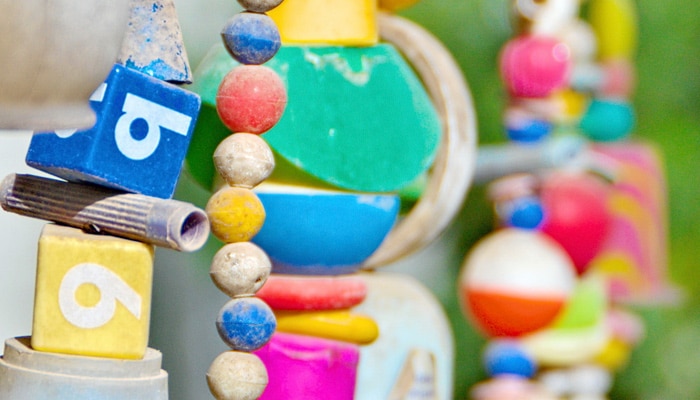While we believe that the books and resources recommended may be of value to you, keep in mind that these are suggestions only and you must do your own due diligence to determine whether the materials are appropriate and suitable for your use. PNC has no sponsorship or endorsement agreement with the authors or publishers of the materials listed.
RECYCLING

Marvelous Mobiles
Children will make a mobile by reusing materials.

Lesson Objective
Children will explore the concept of reusing or repurposing items by creating a mobile with discarded materials.
ScienceArt
What You'll Need
- Wire clothes hanger – 1 per child
- String or yarn cut in 10” to 12” lengths – 4 per child
- Small, clean lids from containers, plastic forks and spoons, yogurt containers
- Scissors – 1 per child
- Glue – 1 per table
- Hole puncher – 1 per adult
- Paper from the recycling bin (used drawing paper, construction paper, newspaper)
- Toys that are going to be discarded, such as puzzles with missing pieces, game pieces like checkers and Legos, dried markers, broken or unwanted costume jewelry, etc.
What To Do
- Tell the children they are going to use a very special kind of art style to make a project called a mobile. A mobile is a piece of artwork that can be made with materials like paper, wood, plastic, metal, string, and wire. It hangs from the ceiling and it moves when air blows on it.
- Display the variety of items and explain that they will be making mobiles from them.
- Talk about some of the items by asking what they are, what they were used for, and why they think the items were in the trash or the recycling bin.
- Provide each child with a hanger and some precut strings. Support the children as they explore the variety of items to think about in deciding how they want to assemble their mobiles.
- Encourage the children to be creative. They can cut them, color them, and use the glue to change their form.
- As the children are tying things onto their hangers, show them how to hold up the hanger and see how the items hang and sway.
- Hang their mobiles around the classroom and remind the children to recycle any leftover scraps.
Resources
Home School Resources
Home educators: use these printable lesson PDFs to teach this lesson to your home schoolers. They're available in English and Spanish.
Content Provided By
Common Core State Standards Initiative – These lessons are aligned with the Common Core State Standards ("CCSS"). The CCSS provide a consistent, clear understanding of the concepts and skills children are expected to learn and guide teachers to provide their students with opportunities to gain these important skills and foundational knowledge [1]. Visit the CCSS


